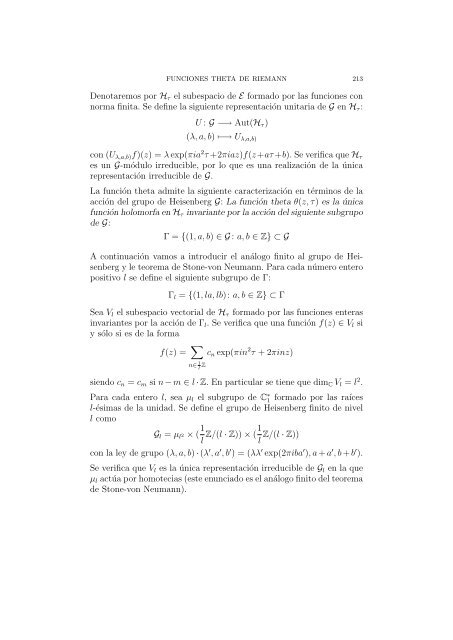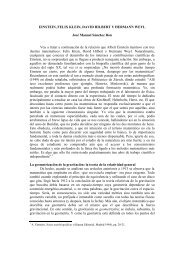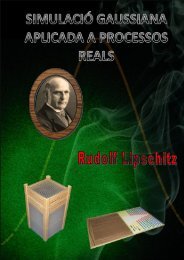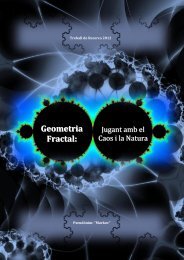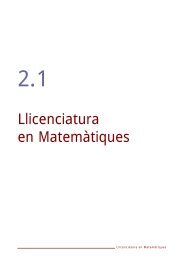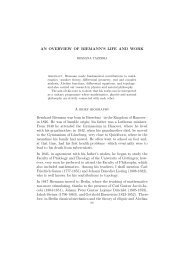FUNCIONES THETA DE RIEMANN 1. Introducción El objetivo de ...
FUNCIONES THETA DE RIEMANN 1. Introducción El objetivo de ...
FUNCIONES THETA DE RIEMANN 1. Introducción El objetivo de ...
Create successful ePaper yourself
Turn your PDF publications into a flip-book with our unique Google optimized e-Paper software.
<strong>FUNCIONES</strong> <strong>THETA</strong> <strong>DE</strong> <strong>RIEMANN</strong> 213<br />
Denotaremos por Hτ el subespacio <strong>de</strong> E formado por las funciones con<br />
norma finita. Se <strong>de</strong>fine la siguiente representación unitaria <strong>de</strong> G en Hτ:<br />
U : G −→ Aut(Hτ)<br />
(λ, a, b) ↦−→ Uλ,a,b)<br />
con (Uλ,a,b)f)(z) = λ exp(πia 2 τ +2πiaz)f(z+aτ +b). Se verifica que Hτ<br />
es un G-módulo irreducible, por lo que es una realización <strong>de</strong> la única<br />
representación irreducible <strong>de</strong> G.<br />
La función theta admite la siguiente caracterización en términos <strong>de</strong> la<br />
acción <strong>de</strong>l grupo <strong>de</strong> Heisenberg G: La función theta θ(z, τ) es la única<br />
función holomorfa en Hτ invariante por la acción <strong>de</strong>l siguiente subgrupo<br />
<strong>de</strong> G:<br />
Γ = {(1, a, b) ∈ G : a, b ∈ Z} ⊂ G<br />
A continuación vamos a introducir el análogo finito al grupo <strong>de</strong> Heisenberg<br />
y le teorema <strong>de</strong> Stone-von Neumann. Para cada número entero<br />
positivo l se <strong>de</strong>fine el siguiente subgrupo <strong>de</strong> Γ:<br />
Γl = {(1, la, lb): a, b ∈ Z} ⊂ Γ<br />
Sea Vl el subespacio vectorial <strong>de</strong> Hτ formado por las funciones enteras<br />
invariantes por la acción <strong>de</strong> Γl. Se verifica que una función f(z) ∈ Vl si<br />
y sólo si es <strong>de</strong> la forma<br />
f(z) = <br />
cn exp(πin 2 τ + 2πinz)<br />
n∈ 1<br />
l Z<br />
siendo cn = cm si n − m ∈ l · Z. En particular se tiene que dimC Vl = l 2 .<br />
Para cada entero l, sea µl el subgrupo <strong>de</strong> C ∗ 1 formado por las raíces<br />
l-ésimas <strong>de</strong> la unidad. Se <strong>de</strong>fine el grupo <strong>de</strong> Heisenberg finito <strong>de</strong> nivel<br />
l como<br />
Gl = µ l2 × ( 1<br />
Z/(l · Z)) × (1 Z/(l · Z))<br />
l l<br />
con la ley <strong>de</strong> grupo (λ, a, b) · (λ ′ , a ′ , b ′ ) = (λλ ′ exp(2πiba ′ ), a + a ′ , b + b ′ ).<br />
Se verifica que Vl es la única representación irreducible <strong>de</strong> Gl en la que<br />
µl actúa por homotecias (este enunciado es el análogo finito <strong>de</strong>l teorema<br />
<strong>de</strong> Stone-von Neumann).


